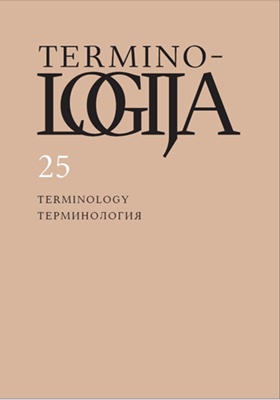Medicinos terminija prieš 100 metų
Medical Terminology 100 Years Ago
Author(s): Palmira ZemlevičiūtėSubject(s): Recent History (1900 till today), Lexis, Baltic Languages, Health and medicine and law
Published by: Lietuvių Kalbos Institutas
Keywords: medicine; term; name; synonyms; variants; live language;
Summary/Abstract: The paper deals with terms collected from over eighty popular science and informational articles on medicine and health published in Lithuanian periodicals (mainly newspapers) in 1918. Terms are analysed in respect of the meaning and expression. Some specialized medical periodicals ceased in 1918, therefore general publications – Moterų balsas, Darbo balsas, Dabartis, Vienybė, Lietuvos aidas, Pavasaris and Tėvynės sargas – started publishing information on the most important health issues, mainly infectious diseases (dysentery, typhus, influenza, etc.), their treatment and patient care. Over 700 different terminological units were collected from the texts researched. 66% of terms are purely Lithuanian words, 17% are foreign words (mainly borrowings of Greek (apopleksija (apoplexy), bakterijos (bacteria)) and Latin origin (kamparas (camphor), daktaras (doctor)) and another 17% are words of mixed origin (hybrids (aptiekininkas „vaistininkas“ (pharmacist), operacinė (operating-room) and complex terms having elements of different origin (valgio virinamieji organai „virškinimo organai“ (digestive tract), ispanų liga „influenca“ (influenza)). The terms researched name body parts and organs, diseases, medical devices, persons, medical institutions and abstract concepts of medicine. One-word terms which are simple words of Lithuanian origin are quite rare (akis (eye), galva (head), plaučiai (lungs)). The majority of terms researched are derivates (nugarkaulis (backbone), kosulys (cough), niežai (scabies), gydytojas (doctor), ligoninė (hospital)). Two-word terms are most frequent (tulžies pūslė (gall bladder), dėmėtoji šiltinė (spotted fever), ricinos aliejus (castor oil), vaistinės padėjėjas (pharmacy assistant), rentgeno kabinetas (X-ray room), three-word terms (vidurių šiltinės mikrobas (typhoid fever microbe), raudonojo kryžiaus ligoninė (Red Cross hospital)) are not very common. There are quite a few synonymous terms in the researched texts (kruvinoji and dizenterija (dysentery), aptieka and vaistinė (pharmacy)). Synonymous terms can be easily identified in the same text because they are used either together or interchangeably. It is more difficult to identify the synonymy between terms from different texts, in such cases the subject of a text, synonymy within the same text, features of the concept or an external source (for instance, LKŽe (Lithuanian Language Dictionary)) may help. In 1918 quite a few medical terms had alternative versions. Phonetic and orthographic variants are common (krūtinė and krutinė (chest), skarlatina and škarletina (scarlet fever), džiova and dziova (tuberculosis) irmedė and irmedė (influenza)), morphologic variants are rare (variants of a gender – karantina and karantinas (quarantine) and of endings – raumenys and raumens (muscles)). Synonyms and variants were used because terminology was not settled; inconsistent usage was also caused by the author’s language knowledge and terminology known to him, editorial or publishing mistakes and the focus on easy and understandable presentation of medical information without paying much attention to expression. Medical terminology of 1918 was influenced by the spoken language. Quite a lot of words – some of them are quite figurative – were borrowed from the colloquial usage (kruvinoji „dizenterija“ (dysentery), mažakraujė „anemija“ (anaemia), gyduolė „vaistas“ (drug), pribuvėja „akušerė“ (obstetrician), krimslys „kremzlė“ (cartilage), kraujo vaikščiojimas „kraujo cirkuliacija“ (blood circulation)). In that year some concepts of medicine still were vague, therefore there are some medical terms which are not precise (ausų užkaitimas, vidurių sluoga, skilvio sugedimas). Medical terminology of 1918 provides an interesting, useful and unique information for the history of medicine in Lithuania (what health issues were topical, what diseases were common and how they were treated, what were the means of prevention, who treated patients and where it was done, etc.) as well as for the research of Lithuanian language and terminology. Some terms which are currently used in the language of medical science were used 100 years ago, but in general medical terminology of that year differs from the modern terminology in figurativeness, Lithuanian origin and variety of meanings and expression.
Journal: Terminologija
- Issue Year: 2018
- Issue No: 25
- Page Range: 147-200
- Page Count: 54
- Language: Lithuanian

